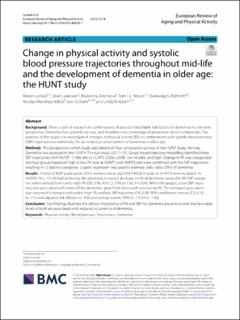| dc.contributor.author | Lerfald, Maren | |
| dc.contributor.author | Lydersen, Stian | |
| dc.contributor.author | Zotcheva, Ekaterina | |
| dc.contributor.author | Nilsen, Tom Ivar Lund | |
| dc.contributor.author | Eldholm, Rannveig Sakshaug | |
| dc.contributor.author | Martinez-Velilla, Nicolás | |
| dc.contributor.author | Selbæk, Geir | |
| dc.contributor.author | Ernstsen, Linda | |
| dc.date.accessioned | 2023-11-09T09:45:40Z | |
| dc.date.available | 2023-11-09T09:45:40Z | |
| dc.date.created | 2023-10-07T15:28:11Z | |
| dc.date.issued | 2023 | |
| dc.identifier.issn | 1813-7253 | |
| dc.identifier.uri | https://hdl.handle.net/11250/3101590 | |
| dc.description.abstract | Background
There is lack of research on combinations of possible modifiable risk factors for dementia in a life-time perspective. Dementia has currently no cure, and therefore new knowledge of preventive factors is important. The purpose of this study is to investigate if changes in physical activity (PA) in combinations with systolic blood pressure (SBP) trajectories in mid to late life are related to development of dementia in older age.
Methods
This prospective cohort study uses data from four consecutive surveys of the HUNT Study, Norway. Dementia was assessed in the HUNT4 70 + sub-study (2017–19). Group-based trajectory modelling identified three SBP trajectories from HUNT1 (1984–86) to HUNT3 (2006–2008): low, middle, and high. Change in PA was categorized into four groups based on high or low PA level at HUNT1 and HUNT3 and were combined with the SBP trajectories resulting in 12 distinct categories. Logistic regression was used to estimate odds ratios (ORs) of dementia.
Results
A total of 8487 participants (55% women, mean age (SD) 44.8 (6.5) years at HUNT1) were included. At HUNT4 70 + , 15.2% had dementia. We observed an overall decrease in OR of dementia across the PA/SBP categories when ranked from low to high PA (OR, 0.96; 95% CI, 0.93 to 1.00, P = 0.04). Within PA groups, a low SBP trajectory was associated with lower OR for dementia, apart from those with decreasing PA. The strongest association was observed for people with stable high PA and low SBP trajectory (OR, 0.38; 95% confidence interval (CI), 0.13 to 1.10 and adjusted risk difference, -8.34 percentage points; 95% CI, -15.32 to -1.36).
Conclusion
Our findings illustrate the clinical importance of PA and SBP for dementia prevention and that favorable levels of both are associated with reduced occurrence of dementia. | en_US |
| dc.language.iso | eng | en_US |
| dc.publisher | BioMed Central Ltd. | en_US |
| dc.relation.uri | https://eurapa.biomedcentral.com/articles/10.1186/s11556-023-00328-1 | |
| dc.rights | Navngivelse 4.0 Internasjonal | * |
| dc.rights.uri | http://creativecommons.org/licenses/by/4.0/deed.no | * |
| dc.title | Change in physical activity and systolic blood pressure trajectories throughout mid-life and the development of dementia in older age: the HUNT study | en_US |
| dc.title.alternative | Change in physical activity and systolic blood pressure trajectories throughout mid-life and the development of dementia in older age: the HUNT study | en_US |
| dc.type | Peer reviewed | en_US |
| dc.type | Journal article | en_US |
| dc.description.version | publishedVersion | en_US |
| dc.source.volume | 20 | en_US |
| dc.source.journal | European Review of Aging and Physical Activity | en_US |
| dc.identifier.doi | 10.1186/s11556-023-00328-1 | |
| dc.identifier.cristin | 2182590 | |
| dc.source.articlenumber | 18 | en_US |
| cristin.ispublished | true | |
| cristin.fulltext | original | |
| cristin.qualitycode | 1 | |

